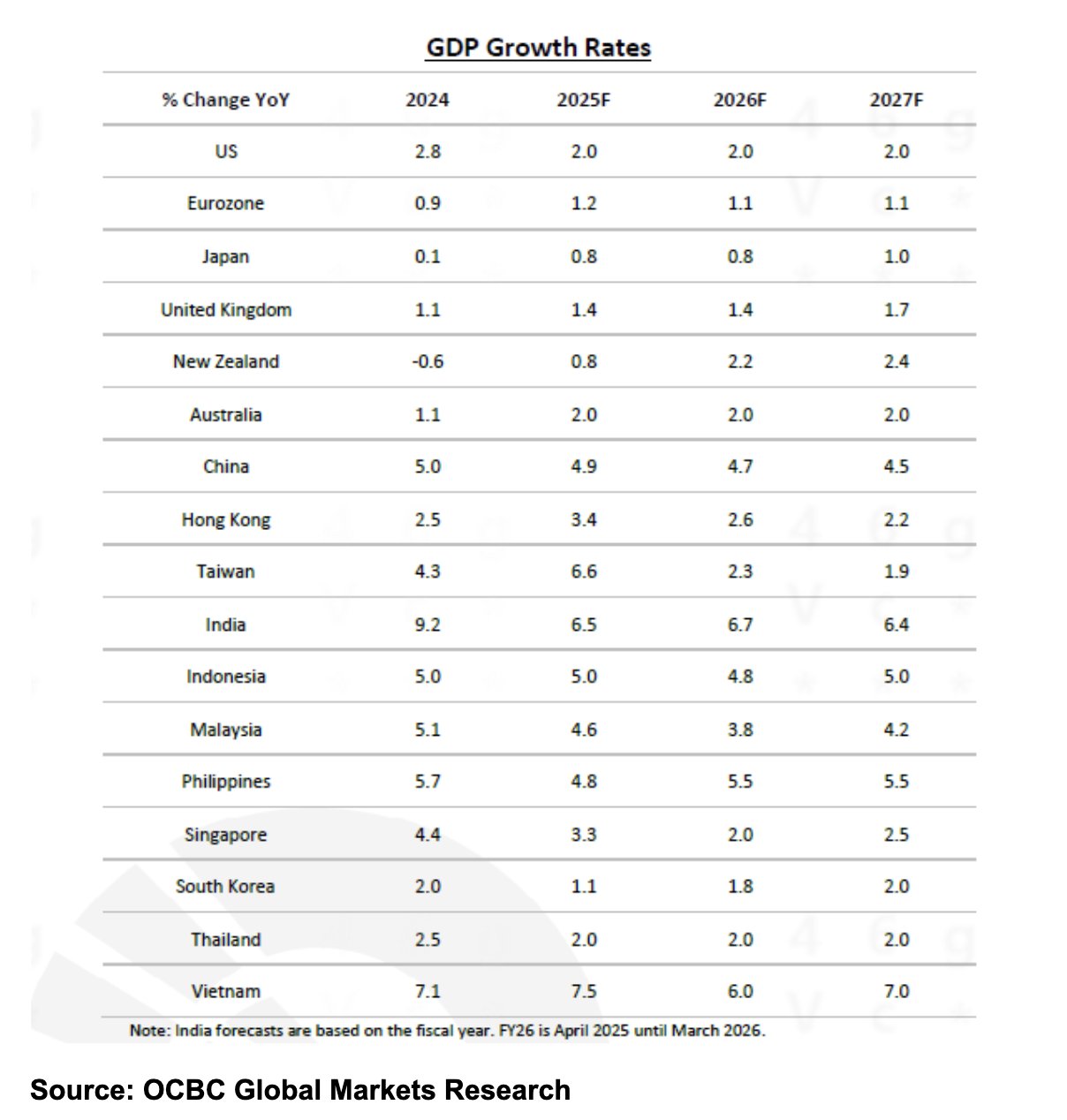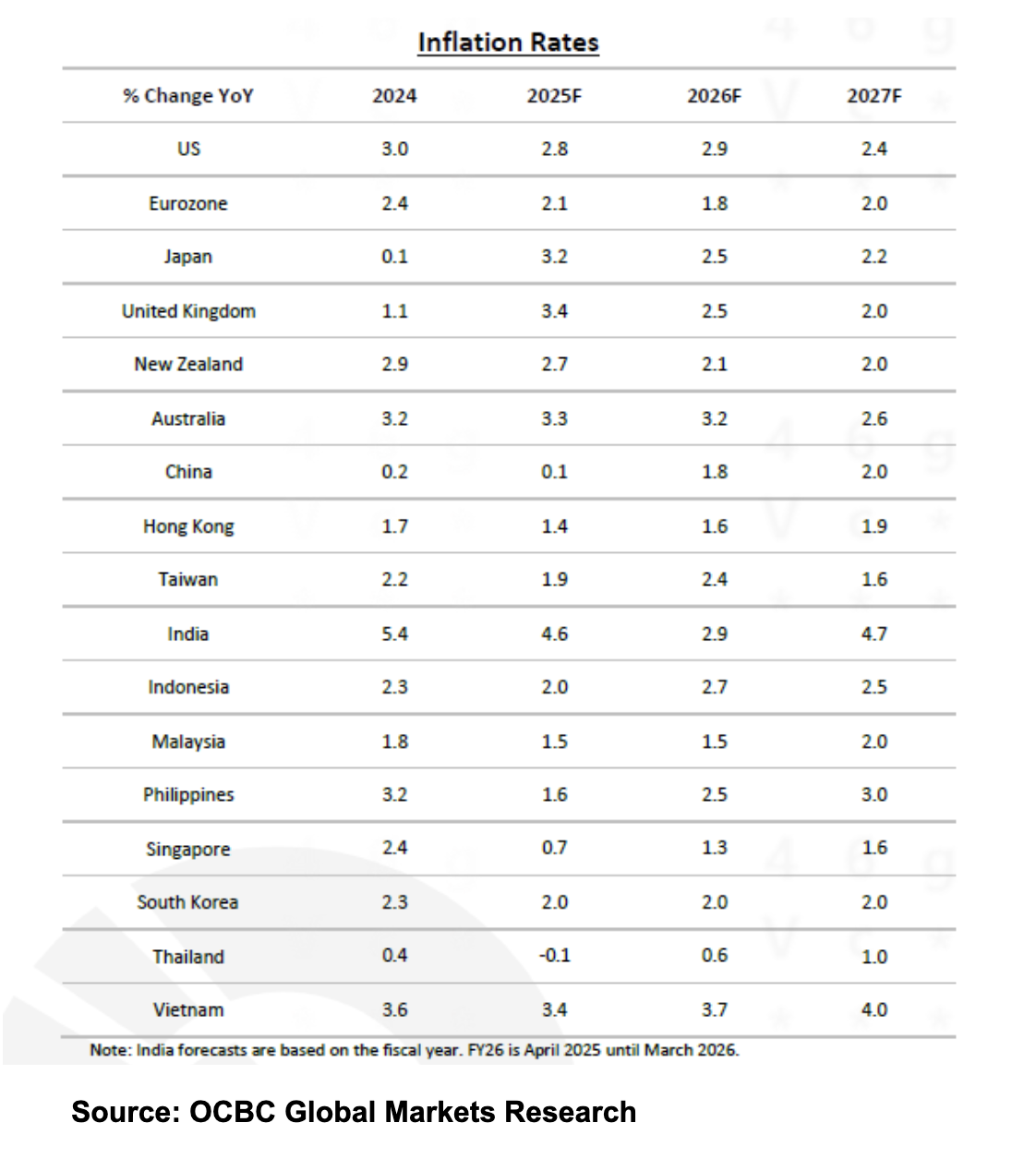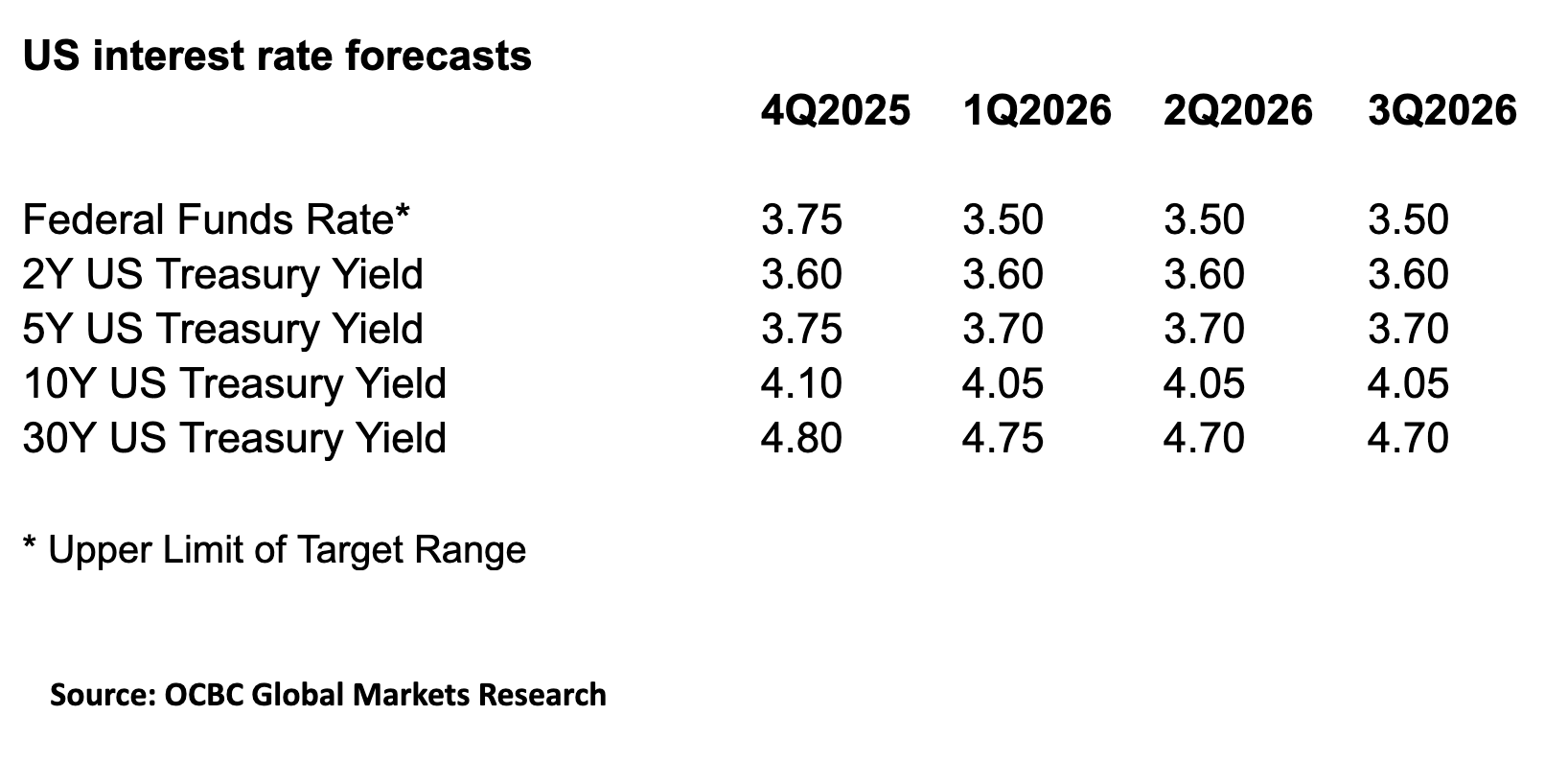Stable economic outlook for 2026
The United States and China reached a trade truce following the Trump–Xi meeting in South Korea on 30 October. Under the agreement, the “fentanyl-related tariff” on Chinese goods will be halved to 10% from the original 20%, while the 24% reciprocal tariff on Chinese products will remain suspended for another year. That said, the existing 10% base tariff will continue to apply, keeping the overall additional tariff rate on Chinese goods at around 20% in 2025 - broadly in line with most Asian peers. The US will also suspend for one year the implementation of the 50% ownership “penetration rule” under export controls, as well as the Section 301 investigations into China’s maritime, logistics, and shipbuilding sectors. In response, China will make corresponding adjustments or temporarily suspend its related countermeasures.
Overall, we see this as a constructive truce that helps reduce uncertainty and stabilise the global economic outlook.
Looking ahead, the outlook for 2026 hinges on three variables: the depth of the US Federal Reserve’s (Fed’s) rate-cut cycle, the trajectory of US-China trade tensions and tariffs, and whether global politics (especially US mid-term elections and whether leadership changes in Europe) catalyse stabilisation or further fragmentation.
The world enters 2026 not in crisis, nor at the start of a new boom, but in a phase of economic regime transition – one that is slower, fragmented but stable.
We see a potentially slower but more stable US growth, a structurally decelerating China, a Europe grappling with competitiveness, and an ASEAN increasingly integrated into global value chains.
The policy environment will be more predictable (with central banks entering a gentle easing cycle), but geopolitics will not. Trade tensions, political elections, and fiscal sustainability issues will continue to cast shadows over markets. Ultimately, 2026 will test whether the global economy can navigate this new equilibrium - one in which growth is modest, inflation manageable, and risks increasingly political rather than macroeconomic. The balance of probabilities favours stability with pockets of volatility. But the blind spots are significant enough to demand humility and vigilance from markets.
United States
Consumer spending remains the key growth pillar. Yet, the combination of K-shaped growth (an economic trend where different parts of the economy experience divergent paths) and the AI boom will likely widen income inequality and complicate policy calibration. Nevertheless, the AI-driven productivity upswing, coupled with fiscal support from the One Big Beautiful Bill Act which is set to kick in from 2026, should underpin the medium-term growth trajectory. Given that the US is less exposed to trade compared to other G10 economies, it is better positioned to weather renewed trade frictions. We expect the US economy to maintain a steady growth pace of around 2% YoY growth in both 2025 and 2026, outperforming most of its developed market peers. We expect headline CPI inflation to hover around 3% YoY in 2026, reflecting persistent price pressures in services and a slow normalisation in core goods inflation.
The Fed lowered the target range for the Fed funds rate by 25bps to 3.75-4.00% at its October meeting, in line with expectation. Our base-case remains for a 25 basis points (bps) cut in the Fed funds rate in December and a 25bps cut in 1Q2026. The risk to our base-case is a delay to the expected December rate cut to 2026. Thereafter, any additional cut will probably require inflation moves near the Fed’s 2% target. Market expectations for more than one Fed rate cut in 2026 still looks dovish to us at this juncture.
US Treasury yields have gyrated in recent weeks given uncertainty about Fed rate policy. We think it is reasonable to expect the 10-Year yield to be in a range of 4% to 4.2% going forward (see table below for our US rates forecasts) considering the range for the breakeven inflation rate of 2.3% to 2.4% and the range for the real yield of 1.7% to 1.8%.
US Treasury yields are essentially composed of two parts: the real yield and the breakeven inflation rate. The nominal yield is the sum of the real yield and the breakeven inflation rate (a market-based measure of future inflation expectations).
Euro-Area
The economy grew by 0.2% QoQ SA (Seasonally Adjusted) in 3Q2025, supported by domestic demand while net exports of goods and services was a drag. The divergence between domestic and external demand may persist for some time. Consumer spending is expected to stay supported as real income rises. Given firmer than expected growth outcomes in 2Q2025 and 3Q2025, we have revised upward our 2025 GDP growth forecast to 1.2% from 0.9% previously. Headline CPI inflation printed 2.1%YoY in October, versus 2.2% in September. Core CPI inflation stayed at 2.4% YoY in October, the same as in September. We maintain our headline CPI forecast at 2.1% for 2025.
The European Central Bank (ECB) kept the three key ECB interest rates unchanged, with the deposit facility rate at 2.00%, main refinancing rate at 2.15% and marginal lending facility rate at 2.40%, at its October policy meeting in line with expectation. The central bank said inflation remains close to the 2% medium-term target and the Governing Council’s assessment of the inflation outlook is broadly unchanged. Lagarde maintains her stance that the central bank is “in a good place”. She highlighted that the policy statement’s paragraph on risk assessment indicated “some of the downside risks to growth have abated”. Christine Lagarde said she would not “complain too much about growth”, referring to the 0.2% QoQ growth for Q3 which was a tad higher than expected based on consensus. While the bias for monetary policy remains mildly on the easing side, the ECB is likely to keep rates unchanged again at the December meeting with growth remaining resilient.
Japan
The economy contracted by a milder than expected 0.4% QoQ in Q3 2025. Recent monthly indicators and surveys point to some recovery in economic activities. September’s industrial production expanded by 3.4% YoY, after two months of YoY contraction. The October Tokyo CPI inflation printed firmer than expected. Prospects remain for the virtuous cycle between wage growth and inflation continues to play out, and as such, further monetary policy normalisation is likely to proceed in a gradual manner.
The Bank of Japan (BOJ) decided to keep its Target Rate unchanged at 0.5% at its October meeting. The voting stood at 7-2 vote with two policy makers voting for a 25bps rate hike. The assessment on the economy and prices has remained pretty much the same; “risks to economic activity are skewed to the downside for fiscal 2026. Risks to prices are generally balanced”. The prospect remains for wage growth to be partially passed onto price levels, in our view. Rengo (the largest trade union in Japan) said it plans to ask for a wage increase of around 5% or more in the "shunto" annual spring wage negotiations for the third straight year in 2026. Meanwhile, enterprises’ short-term (1-year), medium-term (3-year) and long-term (5-year) inflation expectations have stayed firmly above the 2% level, as per the Tankan survey, reflecting a proactive attitude in price-setting. We continue to see the likelihood of a 25bps hike in the BOJ Target Rate before end-2025, and another 25bps hike in 1Q2026 which will then bring the BOJ Target Rate to 1.00%.
China
China’s economy grew by 5.2% YoY in the first three quarters of 2025. We have revised up our annual growth forecast to 4.9% from 4.8% previously.
China outlined seven key social and economic development goals for the 15th Five-Year Plan (2026–2030). The statement from China’s 15th Five-Year Plan suggests that while China will continue to deepen structural reforms, it has not shifted away from its growth ambitions. Nevertheless, five-year plan, prioritising scientific and technological self-reliance, spurring demand and boosting China’s soft power in addition to economic strength, does not detract from the anticipated slowing medium-term growth trajectory. The reference to attaining “moderately developed country” status implies that China’s per capita GDP could rise from the current US$13,500 to roughly US$20,000 to US$30,000 within a decade. This, in turn, points to an implied annual growth target of around 5% during the 15th Five-Year Plan period. We expect China to set its annual growth target to around 5% again for 2026.



The information provided herein is intended for general circulation and/or discussion purposes only. It does not take into account the specific investment objectives, financial situation or particular needs of any particular person. The information in this document is not intended to constitute research analysis or recommendation and should not be treated as such.
Without prejudice to the generality of the foregoing, please seek advice from a financial adviser regarding the suitability of any investment product taking into account your specific investment objectives, financial situation or particular needs before you make a commitment to purchase the investment product. In the event that you choose not to seek advice from a financial adviser, you should consider whether the product in question is suitable for you. This does not constitute an offer or solicitation to buy or sell or subscribe for any security or financial instrument or to enter into a transaction or to participate in any particular trading or investment strategy.
The information provided herein may contain projections or other forward looking statement regarding future events or future performance of countries, assets, markets or companies. Actual events or results may differ materially. Past performance figures are not necessarily indicative of future or likely performance. Any reference to any specific company, financial product or asset class in whatever way is used for illustrative purposes only and does not constitute a recommendation on the same. Investments are subject to investment risks, including the possible loss of the principal amount invested.
The Bank, its related companies, their respective directors and/or employees (collectively “Related Persons”) may or might have in the future interests in the investment products or the issuers mentioned herein. Such interests include effecting transactions in such investment products, and providing broking, investment banking and other financial services to such issuers. The Bank and its Related Persons may also be related to, and receive fees from, providers of such investment products.
No representation or warranty whatsoever (including without limitation any representation or warranty as to accuracy, usefulness, adequacy, timeliness or completeness) in respect of any information (including without limitation any statement, figures, opinion, view or estimate) provided herein is given by OCBC Bank and it should not be relied upon as such. OCBC Bank does not undertake an obligation to update the information or to correct any inaccuracy that may become apparent at a later time. All information presented is subject to change without notice. OCBC Bank shall not be responsible or liable for any loss or damage whatsoever arising directly or indirectly howsoever in connection with or as a result of any person acting on any information provided herein.
The contents hereof may not be reproduced or disseminated in whole or in part without OCBC Bank's written consent. The contents are a summary of the investment ideas and recommendations set out in Bank of Singapore and OCBC Bank reports. Please refer to the respective research report for the interest that the entity might have in the investment products and/or issuers of the securities.
Investments are subject to investment risks, including the possible loss of the principal amount invested. The information provided herein may contain projections or other forward-looking statements regarding future events or future performance of countries, assets, markets or companies. Actual events or results may differ materially. Past performance figures, predictions or projections are not necessarily indicative of future or likely performance.
This advertisement has not been reviewed by the Monetary Authority of Singapore.
This document may be translated into the Chinese language. If there is any difference between the English and Chinese versions, the English version will apply.
Cross-Border Marketing Disclaimers
OCBC Bank's cross border marketing disclaimers relevant for your country of residence.
Any opinions or views of third parties expressed in this document are those of the third parties identified, and do not represent views of Oversea-Chinese Banking Corporation Limited (“OCBC Bank”, “us”, “we” or “our”).





